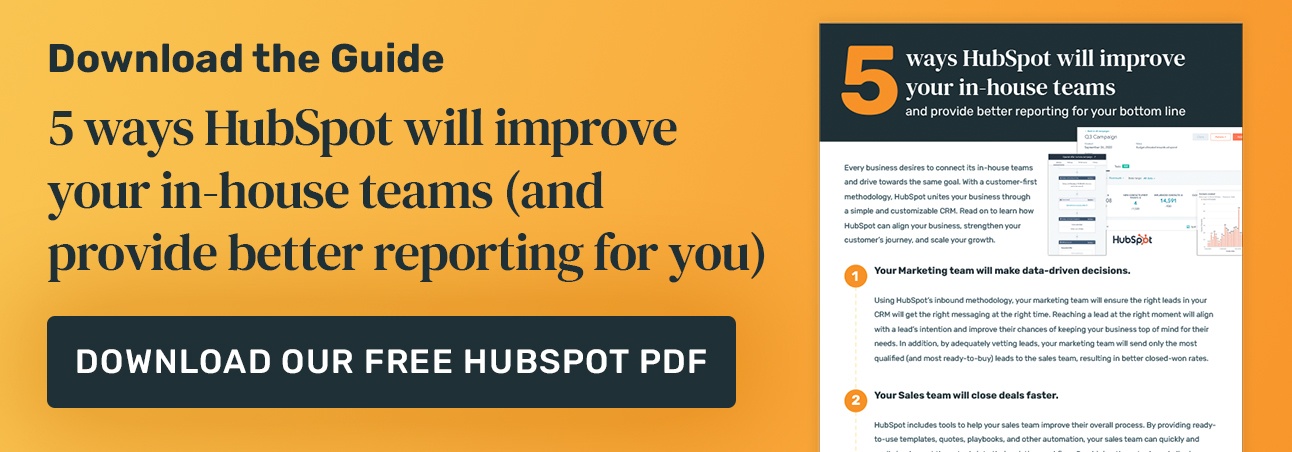How to transition to HubSpot's CRM for marketing

If you’re a marketing professional and don’t use a customer relationship management (CRM) tool, you’ve probably considered adopting one. Or—if you already use a CRM—you might be debating whether HubSpot’s CRM would be a better fit for your company. HubSpot’s CRM is popular for a reason, but the idea of switching to a new company for a tool you rely on can be overwhelming. Learning more about the benefits of HubSpot’s CRM for marketing and how to transition your marketing team can help you decide.
Why switch to HubSpot’s CRM for marketing?
HubSpot’s CRM tool is a popular option for businesses to keep track of customer data and improve communication with leads and customers. While a CRM is clearly beneficial for a sales team, it’s just as helpful in the marketing department. These are a few key benefits of HubSpot’s CRM:
Access free software
While larger businesses might opt for the paid premium software through HubSpot’s Sales Hub, most companies will be well-served by the free standard CRM, which allows users to add and evaluate up to one million contacts. The free CRM also includes several great tools for marketers, like a landing page builder, ad manager, and email marketing tool.
Align business efforts
Your marketing, sales, customer service, and operations teams have distinct but interrelated responsibilities. HubSpot’s CRM helps all of these teams communicate easily and effectively. It also makes it easier to direct each team’s work toward the same overall business goals.
Simplify communication
Having all your customer data and contact details in one place makes it easier to create targeted campaigns and provide a positive customer experience. You can, for example, quickly see where a customer is in the buying process. Then you can determine which marketing email they should receive.
Use multiple integrated tools
Switching to HubSpot’s CRM for marketing doesn’t just organize your customer information. It integrates that data with other essential tools for marketers, including:
- Email marketing tools
- Ad managers
- Form builders
- Live chat capabilities
You can also automate some communication with the chatbot builder and form-builder tools. Since these tools are in the same program as your customer contact information, you can easily use them to connect with specific customers or groups.

How to transition your marketing department to HubSpot’s CRM
HubSpot offers plenty of articles and resources to make adopting its product easier. But this is the basic process you should follow to transition to HubSpot’s CRM for marketing.
1. Consider how you’ll use the new features
Even if your existing process isn’t working well, inertia is powerful, and switching to a new tool can feel intimidating. A tool won’t work if your team doesn’t use it. Before you plan for your transition to HubSpot, think specifically about how you’ll use the new features and how they’ll make your work easier. Then, communicate this information to your team. Upfront buy-in and enthusiasm from the marketing team will make the switch much easier.
2. Make a detailed transition plan
It’s essential to create a detailed plan before you start transferring any data. This will ensure you minimize disruption to your regular operations and avoid any problems with the data you’re migrating. Start by setting a timeline. Decide when you’ll be moving which sets of data and who will be responsible for which tasks.
When making your plan, you’ll also need to consider what you’re using to manage customer information now. If you’re transferring data from an existing CRM, like Salesforce, it will be more straightforward. Since this is a relatively common transition, you’ll be able to refer to HubSpot’s specific resources about importing data from Salesforce. But the data transfer process will be a bit more complicated if you’re using a spreadsheet or, even worse, decentralized notes from different salespeople.
3. Clean up your data
There’s no point in putting bad data into your new CRM tool. So this is an excellent opportunity to review your customer details and delete outdated or irrelevant records. Leads from five years ago are unlikely to be useful, so you’ll probably want to delete them now. Look through your data to find and correct any obvious errors.
Once your data is accurate and up-to-date, format it correctly. HubSpot offers detailed instructions about preparing your data for import, but there are some key requirements to pay attention to, such as matching headers in your spreadsheet to the properties in HubSpot and file size limits.
4. Import your data
Once your data is organized and formatted properly, it’s time to import it into HubSpot’s CRM. HubSpot calls the different types of entries you might make “objects.” The default objects in the CRM are contacts, companies, deals, and tickets. You can also create custom objects if you need to add additional entries.
Depending on what makes sense for your data set, you can upload one object at a time or add more in bulk. HubSpot provides specific import instructions, but the process is pretty simple.
5. Monitor performance and adjust as you go
Once you’ve transferred your data to your new CRM tool, you can start using it. HubSpot recommends aligning your customer data with your sales process. For example, you can set the tool to automatically notify a sales rep when a prospective customer takes a certain action.
Your marketing team can also use the email marketing tool to write targeted messages to customers at different points in the buying process.
Remember that transitioning to HubSpot’s CRM for marketing is just a starting point. As with any tool, you’ll need to monitor how your team uses it and what strategies work for your brand so you can adjust your tactics over time.
Even with a great CRM, handling your marketing can be a complicated and overwhelming responsibility—but it doesn’t have to be! If you’re looking for additional inbound digital marketing support, book a video call with Brightlark Digital to discuss how we can help you reach your goals.
December 29, 2022
